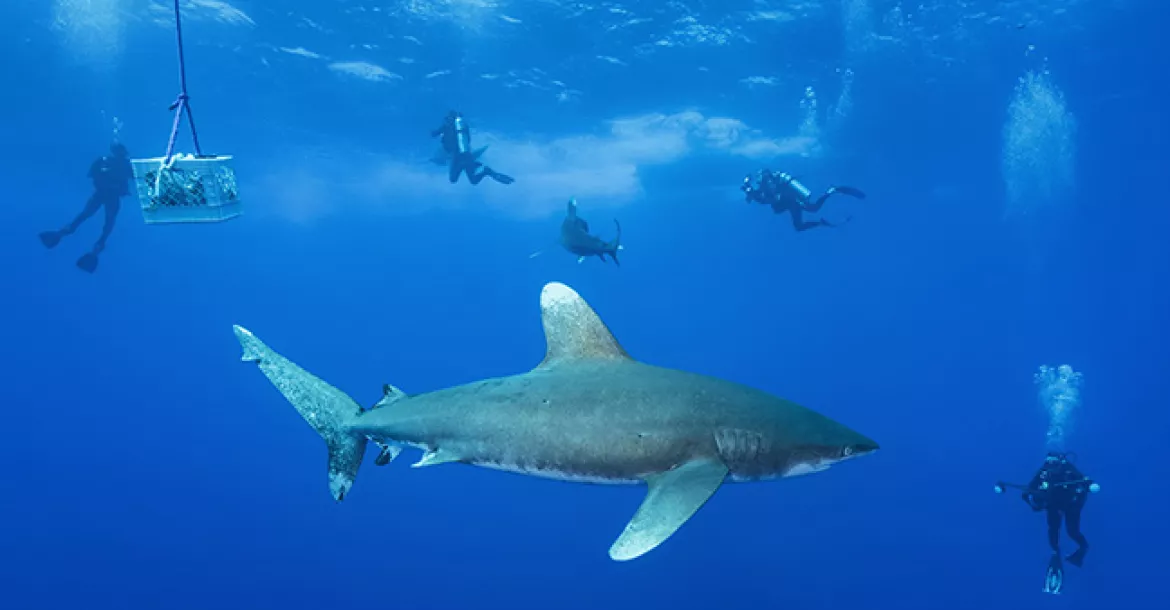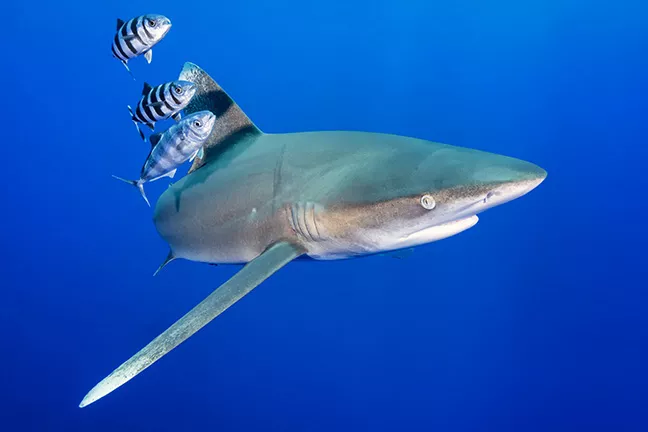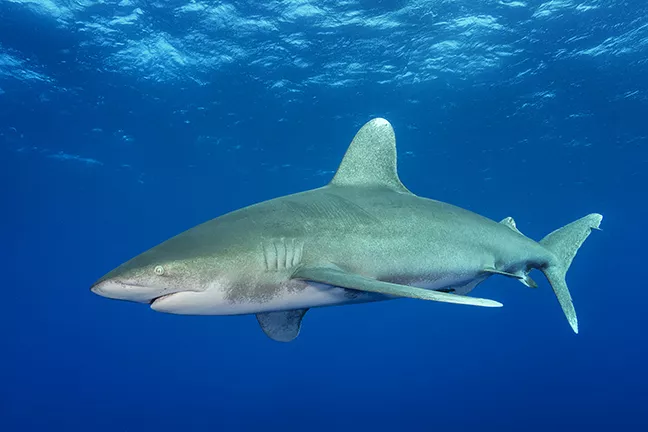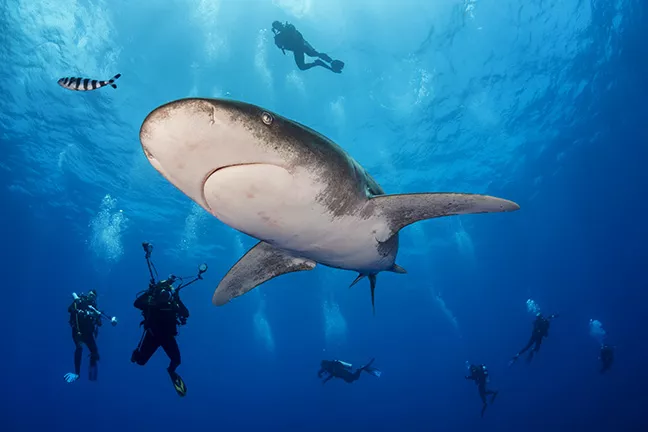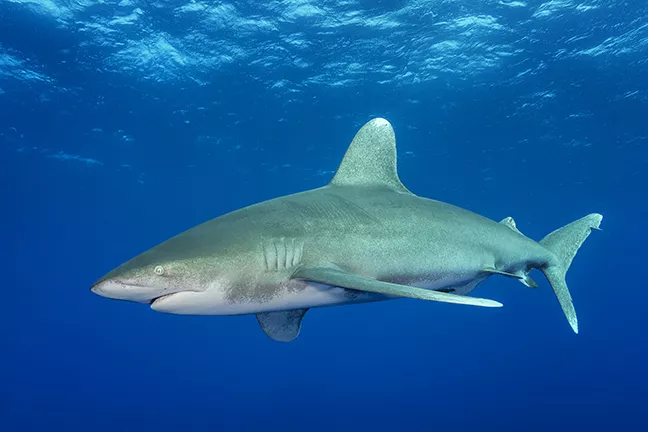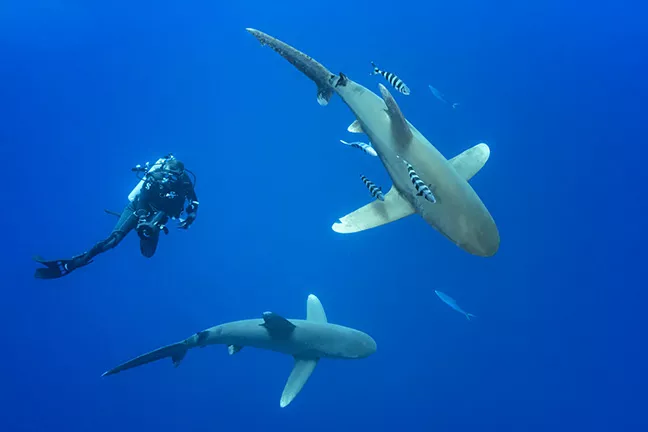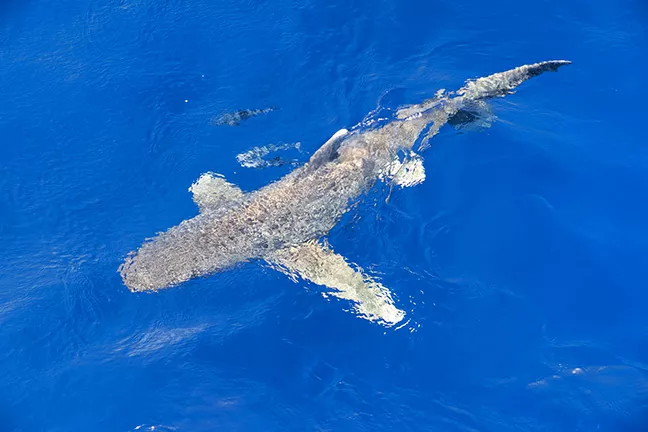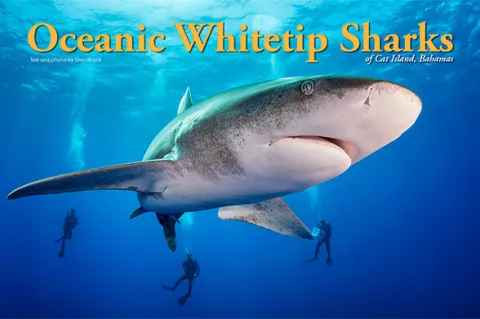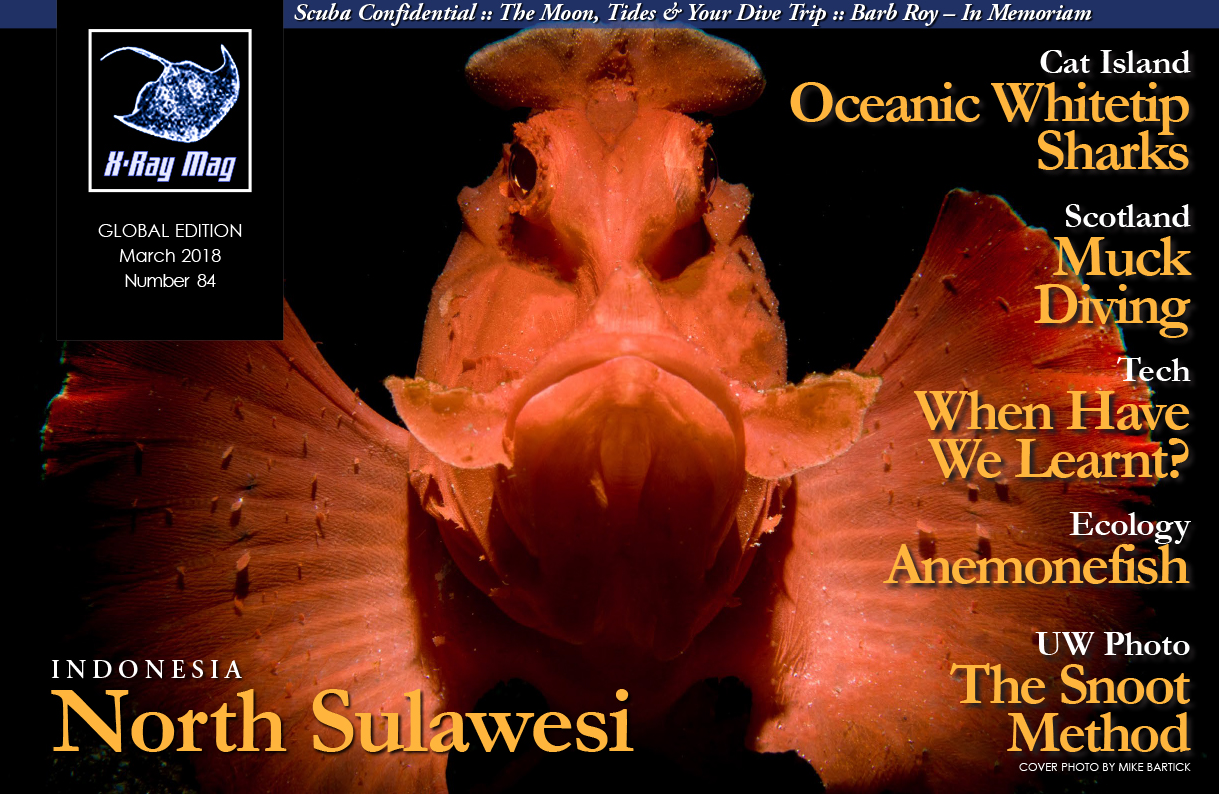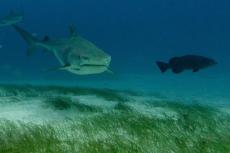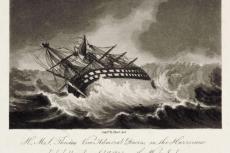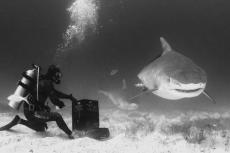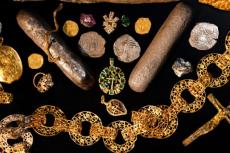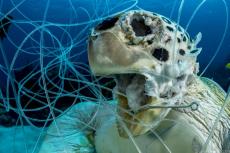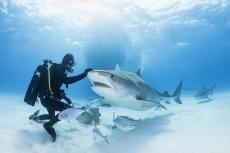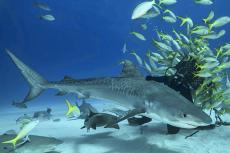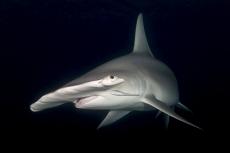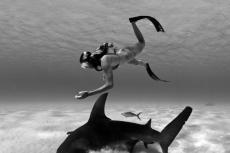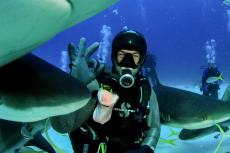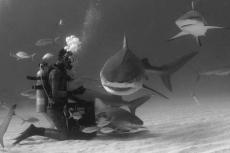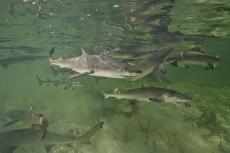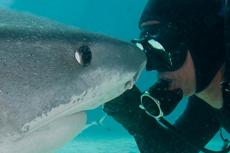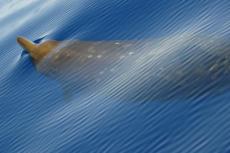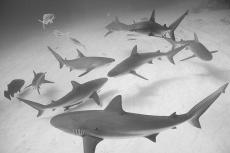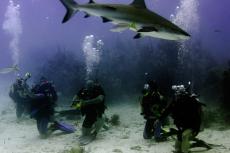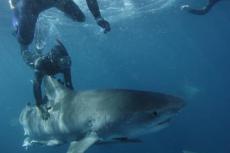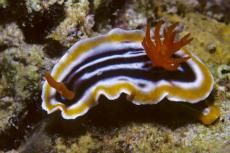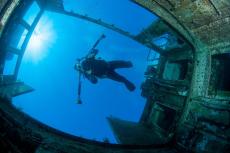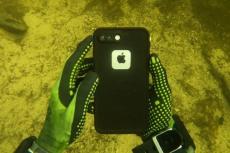
Oceanic Whitetip Sharks of Cat Island
Until quite recently, the Red Sea was generally considered as the best place to see and photograph oceanic whitetip sharks—typically in remote locations such as the Brother Islands and Elphinstone Reef in Egypt or the isolated reefs of southern Sudan. Significantly though, these sightings are generally of lone individuals or very small groups and little is known about the overall population of oceanics in the Red Sea or their migration patterns.
Contributed by
Factfile
Asia correspondent Don Silcock is based in Bali, Indonesia.
For the extensive location guides, articles and images on dive locations in the Indo-Pacific region, visit his website at: Indopacificimages.com.
REFERENCES:
1 http://www.fpir.noaa.gov/Library/PRD/oceanic_whitetip/oceanic-whitetip-status-review-report-2016.pdf
Oceanic whitetip sharks are formidable animals that can reach almost 4m in length when fully mature and have a reputation to match their size, with Jacques Cousteau once describing them as "the most dangerous of all sharks." That said, they do not feature highly on the common shark-attack registers, and it seems it was the sinking of the USS Indianapolis, plus that of the steamship Nova Scotia by a German submarine in WWII, that got them their reputation.
When encountered underwater, they have an intimidating presence and are very inquisitive, seeming to have no fear whatsoever, a combination that comes over as naked aggression when first experienced. They will come in very close and even bump you—often repeatedly, which is obviously quite disconcerting to the uninitiated. But it seems that this is simply their way of checking you out.
Divers who have been in the water a lot with oceanics say that once they work out that you are not easy prey, they leave you alone, which in many ways mirrors what the survivors of the USS Indianapolis said about them.
Cat Island
Once a common sight in the deep offshore waters around the Bahamas, from around the early 1980s, oceanic whitetip sharks became increasingly rare. It was generally assumed they had been completely cleared out by longlining. Although it seemed much too late for the oceanics, as part of their overall conservation program, the Bahamian government banned longlining completely in the early 1990s.
Then, around 2005, the fishing community at Cat Island started to complain about sharks stealing their catches—behavior that oceanic sharks are renowned for. But it was another year before it became clear that something quite special was happening.
Cat Island is a long, thin island that is in the middle of the Bahamian archipelago, on the eastern boundary of the main limestone carbonate platform called the Great Bahama Bank. Its eastern and southern shores sit right on the edge of that bank, and just offshore are the deep blue waters of the western Atlantic Ocean Basin and the rich Antilles Current that sweeps up the coast as it heads north.
It is literally the perfect location to fish for large ocean-open pelagic fish like marlin and tuna, which is exactly what the fishermen were doing. But it is also the perfect spot for oceanic whitetip sharks to reappear again after their enforced absence.
Quite who made the discovery they were back is not clear, as it seems both a BBC film crew and National Geographic photographer Brian Skerry were there about the same time, both following up on the same lead. The significance of the discovery though is incredibly important, because there on the southeastern tip of Cat Island was what appeared to be a healthy population of oceanic whitetip sharks—almost completely opposite to what was happening everywhere else in the world, where declines of 80 to 90 percent had become the norm.
It also provided the first opportunity anywhere for scientists to tag oceanic whitetip sharks and track their movement patterns to try and understand why they were recovering. Because if those lessons could be learned at Cat Island, they could be applied elsewhere. Serious research began in 2010, and since then, some 100 oceanic whitetip sharks have been tagged with satellite tracking devices, so their movement patterns and a variety of other data such as depth and temperature could be established.
Several important results have come to light so far, starting with the fact that while the tagged sharks roamed far and wide in the Atlantic —in some cases, up to 2,000km away from Cat Island—overall, they spent most of the year in the protected waters of the Bahamas. All the sharks spent 99 percent of their time shallower than 200m, but they also all made short 10- to 15-minute dives down to around 1,000m—usually at night, where they stayed briefly and then made a slow ascent back to the surface, which the scientists believe is the oceanic sharks foraging for alternate prey.
Probably the two most significant results, however, are that over time it has become apparent from the large number of sharks being recaptured and retagged, that the overall population of oceanic whitetip sharks at Cat Island may be as low as 300. And secondly, while many of the sharks are pregnant females, there are no indications that they give birth at Cat Island. So, the challenge now is to find the birthing grounds and establish a full cycle of protection. There are indications that the northern coast of Cuba may hold the secret to this, as government scientists there have reported significant numbers of juvenile oceanic whitetip sharks off the small village of Cojímar, but that topic will have to be saved for a future story.
Diving
Over the last five to six years, the Bahamas has firmly established itself as the "shark diving capital of the world", largely because of the tiger and lemon shark encounters at Tiger Beach on Grand Bahama, and dives with the great hammerheads at Bimini. Those encounters are what I would describe as two-dimensional experiences in which you are typically kneeling on a sandy area in shallow water and the sharks usually (but not always) approach you from the front. So, it is all reasonably predictable and relatively easy for the support divers to literally "watch your back."
Cat Island, however, is very much a three-dimensional experience, because you are in blue water and your only point of reference is the white bait crate that is suspended at about 10m. The oceanic sharks are attracted by the scent of the bait in that crate, but are not actually fed, as the mere scent seems to be enough to keep them engaged. And engaged they truly are, exhibiting no apparent fear and approaching extremely close—often to the point of bumping your dome port!
They also sneak up from behind, above and below, often coming so close that they touch you with those long fins. As exciting as all that is, I never really felt in any real danger, as it all seems part of their pattern of testing to see if you are the weakest link and worthy of further investigation.
How it works
Options to dive with the oceanic whitetip sharks at Cat Island are somewhat limited, as the season is short, from the end of March to mid-June, and the island lacks much of the tourism infrastructure of the more popular locations in the Bahamas. That said, the locals are extremely keen to attract tourists in any way they can, so you can be sure of a warm welcome.
I booked my trip with Andy Murch of Big Fish Expeditions (I paid full price out of my own pocket) and he worked with Epic Diving, who base themselves and their boat MW Thresher at Cat Island during the oceanic season. The arrangement worked well for me, as Andy is extremely knowledgeable about anything with fins attached, and Epic were well organized and very capable in the water.
Run by husband-and-wife team Vincent and Debra Canabal, Epic's story is worth telling, as the couple put their professional careers on hold in order to pursue their passion for sharks, shark diving and shark conservation. In Vinnie's case, that was being a hospital emergency-room physician in New Jersey, something he still does in the off-season, while Debra worked as an animal nutritionist, after completing a Ph.D. in biomedical science.
It is very much a family business. While Vinnie and Deb are running the boat and diving, Deb's mother homeschools the couple's two children at Cat Island, and Vinnie's sister runs the reservation and booking systems.
Bahamas marine protection
The Bahamas was one of the first countries to understand the importance of sharks to their seas and fish stocks. The growth of shark tourism has proven that live sharks are much more valuable than the dead and de-finned variety—plus, they generate a recurring source of revenue.
That said, the country was never at the leading edge of the conservation movement. It has suffered from over-exploitation of its fish stocks over the years and periodic over-development of tourist resorts in ecologically sensitive areas. But there is no major industry in the country, and its people generally have a deep and visceral understanding of the importance the health of their surrounding waters is to their long-term prosperity.
Therefore, the establishment of the Bahamas National Trust in 1959 to manage the world's first marine protected area—the 112,640-acre Exuma Cays Land and Sea Park—can now be viewed as an incredible piece of foresight. The Bahamas have since added another 26 national parks covering over one million acres of land and sea, together with enacting substantial supporting environmental legislation, including making Exuma Cays a no-take marine reserve.
Then, in 2011, the government went one step further and became the fourth country in the world to establish a shark sanctuary by formally protecting all sharks in Bahamian waters. It seems clear that the reappearance of a small but healthy population of oceanic whitetip sharks at Cat Island would never have happened if the government had not taken those measures. Nature is amazing and can produce astonishing things if we humans can only give it the chance to do so.
History of shark finning
It seems almost unbelievable that as recently as the mid-1960s, the oceanic whitetip shark (Carcharhinus longimanus), was widely considered to be one of the most abundant large animals in the world. And now, just over 50 years later, these sharks are on the IUCN Red List, categorized as "Vulnerable" globally and "Critically Endangered" in the northern and central western areas of the Atlantic Ocean.
As for when the decline of shark populations started, some point to the moment when Deng Xiaoping came into power in China and unleashed the economic reforms that have lifted hundreds of millions of people out of abject poverty. In the process, a burgeoning middle class was created, currently estimated at around 100 million—but growing rapidly—and all looking for ways to show off their new wealth. One way was to consume the thick, fibrous and expensive concoction called shark fin soup.
While there is much to admire about Deng Xiaoping and the incredible economic growth he enabled, there have been very visibly dark sides to letting the Chinese entrepreneurial genie out of its bottle, including pollution which plagues the nation's cities. Less obvious though is the appalling impact that the conspicuous consumption of the Chinese middle class is having on the world's oceans. While the general public hears about the shark fin trade and periodically sees the hideous images of row upon row of fins drying on the roofs of Hong Kong warehouses, divers know firsthand the impact shark finning has had on the seas: We rarely see sharks underwater.
Roaming free
In so many ways, the oceanic whitetip shark personifies this hidden impact. It is an open-water pelagic animal, near the top of the marine food chain, which has evolved superbly to wander the upper water column of the world's oceans. Found in all tropical and sub-tropical waters across the Atlantic, Pacific and Indian Oceans, but rarely seen in coastal waters, oceanic whitetip sharks roamed free in a never-ending search for food and, with few predators and limited industrial-scale fishing, the sheer bounty of the oceans had allowed it to become such a populous species.
But as the market for shark fins expanded almost exponentially in China, so did the demand for large, open-ocean fish such as tuna, mackerel, mahi-mahi and swordfish, leading to the development of the deadly fishing methodology referred to as "longline." Despite the rather innocuous sounding name, longlining is designed to catch those apex open-ocean fish and does so with devastating efficiency using a thick main line, which is laid out and suspended from buoys every 100m or so. Connected to those main lines are many shorter lines that have baited hooks attached to them and a single longline can be up to 50km long with over 12,000 baited hooks!
While the ethics of longline fishing can be debated—with proponents arguing it is simply meeting a demand for the highly prized open-ocean fish—what cannot be defended is the devastating "bycatch" that it produces. Yet another innocent-sounding term, bycatch refers to the creatures that are not the object of the overall mission and are simply caught by accident.
Seabirds, for example, are especially vulnerable to longlining because they are attracted to the scent of bait in the water, which they follow only to become victims on the "line of death." The exact number of seabirds lost to bycatching is impossible to measure accurately, but credible scientific estimates put the number killed each year at between 150,000 and 300,000!
Oceanic whitetips as bycatch
Oceanic whitetip sharks spend the vast majority of their time roaming in what scientists call the "surface mixed layer" of the water column, which in layman's terms means from the surface down to about 150m. This is basically their domain and where they are the apex predators, traveling slowly but efficiently over great distances with their large, almost winglike, pectoral fins—or longimanus, roughly translated as "long hands".
In that mixed layer are the tuna, barracuda, swordfish and white marlin, which are the oceanic whitetip shark's principal source of food. But it is also where the longlining fishing boats concentrate much of their efforts.
As they are such opportunistic feeders, oceanic whitetip sharks are drawn onto the line of death in astonishing numbers, with very clear indications that it has caused population declines of at least 70 to 80 percent in all three ocean basins—Pacific, Atlantic and Indian. While oceanic whitetip sharks are not specifically targeted by the longliners, they provide a lucrative sideline, because their large and distinct fins are highly prized in the international fin trade.
Size matters to the Chinese, and the fact that the key ingredient in the trophy soup served at banquets and weddings comes from an apex predator carries a very special cachet to the increasingly status-conscious middle class.
The really appalling aspect of oceanic whitetip bycatch though, is that because their meat is considered low in value, the sharks are usually separated from their prized appendages and then thrown back into the water alive to drown! This hideous practice has gone on for many years, and while there are signs it is now changing in regulated areas such as the US Northwest Atlantic, there is little doubt that it continues unabated in less controlled areas.
Then there is the really dark side known as "IUU" (Illegal, Unreported, and Unregulated) fishing. With IUU fishing, there is no doubt at all about what happens to oceanic whitetip sharks when they are caught as bycatch.
Hope springs eternal
While it is far too early to declare, or even consider declaring, any kind of victory in the journey to reverse the population decline of oceanic whitetip sharks, there is cause for a degree of optimism. Two main things have brought this about.
Firstly, there was the recruitment of prominent Chinese celebrities, such as former Houston Rockets basketball star Yao Ming, to the WildAid campaign of raising awareness of the impact of eating shark fin soup. The fame that the 7.5-feet-tall Yao Ming gained in the United States has made him an absolute mega-star in China, so the credibility he brings to the campaign is simply immense.
When WildAid began its campaign in 2006, their research showed that 75 percent of the Chinese surveyed were unaware that shark fin soup actually involved sharks because the literal Mandarin translation is "fish wing soup.” Furthermore, about 19 percent of those surveyed believed that the fins actually grew back again!
Yao Ming's commitment to the campaign has had a huge impact, and it is said that eating shark fin soup is now almost shameful for young middle-class people, which is an incredibly positive development. But in a country of 1.3 billion people and a middle-class of 100 million, it is obviously just a drop in the ocean.
Secondly, and more significantly perhaps, is the way the Chinese government is getting behind certain aspects of conservation, and specifically, the anti-shark-fin campaign. The actions taken so far are very positive—such as closing shark fin speciality restaurants in major cities like Shanghai and Beijing, plus making it illegal to consume the soup at all official banquets.
Recent studies of the global shark fin trade indicate that the market is in fact declining. So, while there remains much to do, it would appear that the lowest point may be behind us.
Conservation status
While the oceanic whitetip shark has been placed on the IUCN Red List as "Vulnerable" globally and "Critically Endangered" in the northern and central western areas of the Atlantic Ocean, there appears to be much discussion in the scientific community about the data used for those assessments and the overall status of oceanic whitetip sharks globally.
Specifically, there is a lack of robust data for the South Atlantic and Indian Ocean. Plus, there are indications of improvement with the situation in the Northwest Atlantic and Hawaii areas. So, scientists do not want to be accused of over-reacting. Then, there is the concern about the wide range that oceanic whitetip sharks roam, which could mean that either they are not being accounted for in the population estimates and bycatch numbers, or are being counted twice.
The most recent assessment of the current status of oceanic whitetip sharks globally is a comprehensive 25-page review by the American scientific agency NOAA (National Oceanic and Atmospheric Administration), which was released a at the end of 2016.1
It is a long and complex read, but NOAA basically drew the following principal conclusions:
- "Given the species' significant historical and ongoing abundance declines of varying magnitudes in all three ocean basins, slow growth, low fecundity, and low genetic diversity, combined with ongoing threats of overutilization and largely inadequate regulatory mechanisms, the ERA (Extinction Risk Analysis) team concluded that the oceanic whitetip shark currently has a moderate risk of extinction throughout its global range."
- "In other words, due to significant and ongoing threats of overutilization and largely inadequate regulatory mechanisms, current trends in the species' abundance, productivity and genetic diversity place the species on a trajectory towards a high risk of extinction in the foreseeable future of ∼30 years."
This basically means that there is still time to reverse the situation. But if things do not change, the probability is that this animal that was so recently extremely abundant could be extinct within the next 30 years.
The Indianapolis
No story about oceanic whitetip sharks would be quite complete without a reference to the sinking of the heavy cruiser USS Indianapolis in the final months of WWII. Torpedoed during the early hours of 30 July 1945 by the Japanese submarine I58, the attack was devastatingly successful and involved just two torpedoes. The first struck the bow and the second hit the midship, sinking the Indianapolis within 12 minutes—so fast was the overall attack that about 300 of the nearly 1,200 crew went down with the ship.
Many of those who managed to scramble off the stricken ship did so without lifeboats or lifejackets, and were forced to cling to debris in the open sea. Bad as that was, the worst was yet to come, because in a series of almost unbelievable administrative blunders, the ship was not reported missing.
For 3.5 days, the poor sailors were left to the mercy of the sea until a passing plane spotted the wreckage and alerted the US Navy, which immediately despatched rescue ships. But, by the time they arrived a day later, only 316 were still alive.
Most of the victims died from exposure to the elements and lack of water, but enough had succumbed to predatory shark attacks—later attributed to oceanic whitetip sharks—that the animal has permeated into the modern psyche as a ruthless and deadly killer. Nobody knows how many shark attack victims there actually were, but a recent National Geographic article paints a more balanced story as a result of talking to actual survivors, many of them now in their nineties.
By far, the biggest problem the survivors said they faced was the lack of fresh water, and many of the sailors that died did so after succumbing to horrendous thirst and drinking seawater. They all said that the prowling sharks were a concern and would approach closely, often bumping them, but could be easily kicked or pushed away.
Overall, it would seem that the oceanic whitetip sharks went for the dead or nearly dead sailors. As horrendous as that must have been, it is a significantly different story than the urban myth about oceanic whitetip sharks systematically attacking the seamen, one by one. ■
